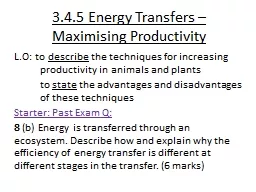

Maximising Productivity LO to describe the techniques for increasing productivity in animals and plants to state the advantages and disadvantages of these techniques Starter Past Exam Q ID: 606088
Download Presentation The PPT/PDF document "3.4.5 Energy Transfers –" is the property of its rightful owner. Permission is granted to download and print the materials on this web site for personal, non-commercial use only, and to display it on your personal computer provided you do not modify the materials and that you retain all copyright notices contained in the materials. By downloading content from our website, you accept the terms of this agreement.
Slide1
3.4.5 Energy Transfers – Maximising Productivity
L.O: to
describe
the techniques for increasing productivity in animals and plants
to
state
the advantages and disadvantages of these
techniques
Starter: Past Exam Q:
8
(b) Energy is transferred through an ecosystem. Describe how and explain why the efficiency of energy transfer is different at different stages in the transfer. (6 marks)Slide2
Past Exam Question Jan 2010
8
(b) Energy is transferred through an
ecosystem. Describe
how and explain why the efficiency of energy transfer is different at
different stages
in the transfer
. (6 marks)Slide3
Answers
1
Some light energy fails to strike/is reflected/not of
appropriate wavelength;
2 Efficiency of photosynthesis in plants is low/approximately
2% efficient;
3 Respiratory loss / excretion / faeces / not eaten;
4 Loss as heat;
5 Efficiency of transfer to consumers greater than transfer to
producers/approximately 10%;
6 Efficiency lower in older animals/herbivores/ primary
consumers/warm blooded animals/
homoiotherms
;
7 Carnivores use more of their food than herbivores;Slide4
If I am the answer…what is the question?
1
Slaughtered when still growing/before maturity/while young
so more energy transferred to biomass/tissue/production;
2 Fed on concentrate /controlled diet /controlled
conditions/so higher proportion of (digested) food
absorbed/lower proportion lost in faeces / valid reason for
addition;
3 Movement restricted so less respiratory loss / less energy
used;
4 Kept inside/heating/shelter / confined so less heat loss / no
predators;
5 Genetically selected for high productivity;Slide5
Past Exam Question Jan 2010
8
(c) Explain how the intensive rearing of domestic livestock increases net productivity
. (4 marks) Slide6
http://www.youtube.com/watch?v=rEkc70ztOrc&feature=plcp
Slide7
Mini Presentations
Pesticides
Biological Control
Integrated Pest Control
FertilisersSlide8
Mini Presentations
Suggested
Format:
Slide 1: Name of technique
Slide 2: What that technique is
Slide 3: Advantages
(why it’s used to maximise productivity)
Slide 4: Disadvantages
Slide 5 (extension) : Case Study / Examples
Remember to keep text on the slide to a minimum please! Slide9
Past Exam Question Jan 2011
Q) Managed
ecosystems such as wheat fields are prone to pest infestations.
Describe the
advantages and disadvantages of using biological agents to control pests
. (5 marks)Slide10
Answers
Advantages
1. Specific (to one pest);
2. Only needs one application/ reproduces;
3. Keeps/maintains low population;
4. Pests do not develop resistance;
5. Does not leave chemical in environment/on crop / no bioaccumulation;
6. Can be used in organic farming;
Disadvantages
7. Does not get rid of pest completely;
8. May become a pest itself;
9. Slow acting/ lag phase/ takes time to reduce pest population; Slide11
http://www.youtube.com/watch?v=gX1FLXEo96g